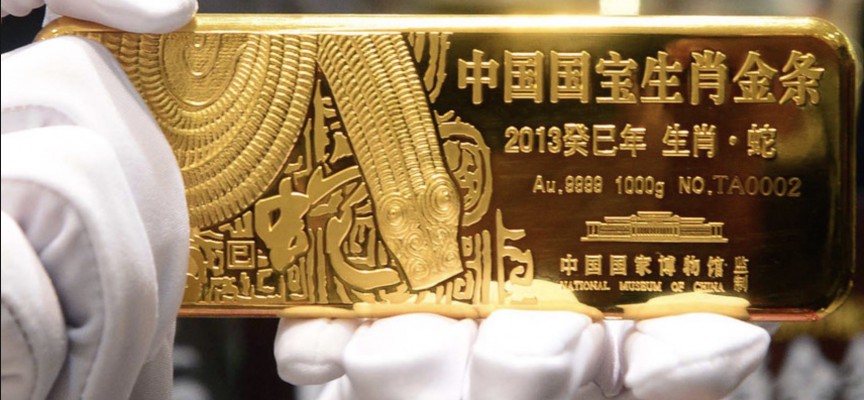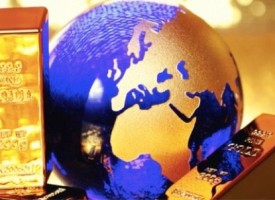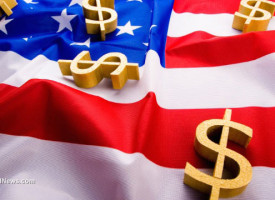Ahead of this year’s Winter Olympics being featured in Beijing, China is making serious moves in the gold and currency markets as the world edges closer to a new monetary system.
Fading US Dollar Hegemony
January 12 (King World News) – Dr. Stephen Leeb: The odds that the dollar can keep its role as a reserve currency have gotten ever shorter, with several recent developments pointing to major pieces for a new reserve system falling into place.
The new monetary system, as I’ve discussed before, once fully implemented will be linked to gold. You may have noticed that it has become more common lately to hear talk about the dollar being replaced. But you rarely hear anyone bring up gold. That’s hardly surprising, and don’t let it fool you into thinking it means gold won’t come into play.
If gold were invoked at this stage, it would likely lead to a chaotic surge in the metal, pushing it perhaps to $5,000 or even higher very rapidly. That would disrupt an orderly transition to a new system. It’s why, until enough i’s are dotted and t’s crossed to let gold’s initial gains occur in a measured fashion, you’re not likely to hear gold brought into the conversation.
Initially the new reserve currency will likely be based in the East and revolve around the yuan. But the longer-term goal will be a basket of currencies backed by a flexible gold standard and used by East and West alike. Gold’s eventual target will depend on many factors, including potential resource scarcities, but as a round number, $20,000 seems about right. If that sounds improbably high, remember that the DJIA, now at 36,000, traded below 800 two generations ago.
Gold Will Surge Well Above $5,000
I’ll get to the aforementioned recent developments in a moment. First, though, a few comments on the volatility we’ve been seeing in the gold market. Far from suggesting gold lacks the ability to anchor a new monetary system, it should be seen as indicating a desperate effort – destined to be futile – to avert the coming changes. Gold’s volatility in the context of new all-time highs in raw commodities, including foodstuffs and raw industrials, along with near-record negative real yields, provides the kind of environment to induce dollar fears and gold havens. The last time commodities traded at current levels, 10-year yields were more than twice today’s levels, and inflation – measured by comprehensive measures, not just commodity inflation – was far lower than today. Gold’s volatility may persist a while longer. My guesstimate is that gold will be bounded by $1,680, and more likely $1,720-$1,750, on the downside. Then, a realistic first target is $5,000 with much higher prices thereafter…
To find out which silver company just made a major acquisition that will
quadruple their production click here or on the image below

Saudi Arabia & China Forming Very Close Ties
Now for the developments that have brought the new monetary system closer into view. On November 9, The Wall Street Journal ran an opinion piece by Karen Elliot House, an award-winning journalist, former WSJ publisher, and author of a book on Saudi Arabia. Her article, entitled “Saudi Arabia Turns Toward China”, details the increasingly close ties between the Saudis and China.
An unnamed advisor to Saudi Crown Prince Mohammed bin Salman was quoted as saying:
“You name it and we are doing it with China.”
To facilitate the relationship, the Saudi Kingdom is teaching Mandarin in schools. China is the Saudis’ largest trading partner. The major export, of course, is oil, while military hardware and technologies have become vital imports.
Nor should this come as a surprise, given that the U.S. no longer sells the Saudis offensive weapons and recently removed the defensive Patriot missiles. The current Saudi-China closeness is compensating, and then some, for cooler Saudi-U.S. ties.
More recently, the Journal reported that the Saudis have begun to make ballistic missiles using Chinese technology and Chinese experts. This military cooperation comes in the wake of multiple drone attacks against the Saudis and their oil infrastructure. The most successful of these assaults, in September 2019, temporarily reduced Saudi oil production by half.
By a large margin, the Saudis are the big gun in Mideast oil. If there is a No. 2 among the Gulf states, it would be the United Arab Emirates, and evidence is growing that this formerly neutral country, too, now strongly favors China. According to the Financial Times, the UAE and the U.S. have postponed talks concerning the proposed $23 billion purchase of 50 F-35s. The reason was U.S. insistence that the UAE drop plans to install Huawei 5G equipment and that it forbid China to build a military outpost on the UAE coast. “Postponement” of talks is a euphemism for cancellation of the purchase, as the UAE has ordered nearly comparable planes from the French.
China Now Protecting Saudi Oil Fields
While China is the largest trading partner for both the UAE and Saudi Arabia, its role in protecting Saudi oilfields is particularly significant. The quid pro quo decades ago that led to the petrodollar replacing the gold-backed dollar was an agreement that the U.S. would protect Saudi oilfields and the transit of Saudi oil in exchange for the Saudis pricing oil in dollars. That agreement was the critical foundational step that let the dollar maintain its role as the world’s reserve currency, with world trade priced in dollars.
China, Oil & Gold
I’ve argued for several years that China, starting with the Shanghai oil exchange in which oil sales are de facto backed by gold, intends not just to price discovery mechanisms such as commodity exchanges in gold-backed currencies but also major oil delivery contracts. One obstacle has been that many U.S. weapon systems – and especially the F-35s – allow their users to be monitored, with cameras in virtually every corner of the planes recording pilot actions. Moreover, the features available to pilots can also be monitored. This kind of monitoring acted as a sort of assurance, and pilots were not necessarily comfortable in operating the complex machinery. The Chinese strategy, which meshes with new Arab thinking, is that weapons’ operators should be autonomous…
VERY BIG DEAL!
This exploration company just made one of the biggest
acquisitions of 2021 that stunned investors!
To learn more click here or on the image below

China & Iran
The Chinese are totally transactional in their friendships, willing to work with countries whatever their internal dynamics. They have no problem befriending Gulf states at the same time as they work with those states’ sworn enemy, Iran. Indeed, their friendship with Iran is something they bring to the table in negotiating oil contracts in currencies other than the dollar. You would have to be very naïve to believe that the Iranians weren’t behind drone strikes on the Saudi fields, which the U.S. can’t control but which occur because of U.S.-Iran enmity. By contrast, China has recently signed a 50-year agreement with Iran, a sign of its major influence in the country.
There have been broader developments as well. It’s notable that the Regional Comprehensive Partnership (RCEP) – the largest trade deal in history – starts to take effect this month. RCEP encompasses 15 countries in Asia and Southeast Asia. They include the 10 countries that are part of ASEAN (Association of Southeast Asian Nations) – Brunei, Cambodia, Indonesia, Laos, Malaysia, Myanmar, the Philippines, Singapore, Thailand, and Vietnam – plus China, Japan, South Korea, Australia and New Zealand. Together the signatories account for 30% of world GDP and contain approximately 2.2 billion people.
The fact that the countries in this deal include two staunch allies of the U.S. – Japan and Australia – as well as the somewhat less-staunch South Korea – strongly points to the East emerging as an economic bloc. India also negotiated with the signatories but eventually dropped out, though it’s possible it will join at some future time. The Brookings Institute estimates that RCEP will add about $500 billion to world trade by 2030 as it knits together most of Asia as an economic bloc. Approximately 90% of the trading gains will accrue to the Asian signatories.
China To Launch Digital Currency At Winter Olympics
The timing of the deal’s culmination is significant, coming as it does one month before the Winter Olympics being held in China, a time when China plans to launch its digital currency, known as the Central Bank Digital Currency (CBDC). While the CBDC is initially intended for use as a domestic currency that will replace China’s paper yuan, the longer-term near-certainty is that it will become an international currency. And crucially, it will be backed by gold, as was made plain, among other signs, by an animated infomercial China released a while back to its citizens about the CBDC in which the currency’s avatar was the color gold.
The CBDC would offer multiple advantages over the current U.S. SWIFT system, which is really just a messaging protocol among banks to alert them to where goods in transit reside and how much money must be kept in escrow. SWIFT has been used (and often abused) by the U.S. to enforce sanctions. The CBDC not only will be simpler and more secure thanks to its state-of-the-art blockchain, it also will be less costly in that less escrow funds will be required. And I expect it will lead to a gold-backed monetary system. Keep in mind that China’s International Gold Exchange allows any seller of goods to exchange yuan – which will shortly be in the form of a digital token – to be exchanged for gold.
In taking a step-by-step approach, the Chinese may have in mind the frog-boiled-in-water idea. If you put a frog in water that’s already boiling, the frog will quickly jump out. But if you turn the heat up very slowly, the frog will be lulled until it’s too late. The CBDC’s use of gold backing may follow the same guidelines among the Asian trading partners. The Middle East may be quicker than Asian countries to warm to the idea.
To sum up: The initiation of RCEP along with the CBDC sets the stage for a new monetary currency system, which will at least be de facto backed by gold.
Some major questions remain. Among them, will the U.S. be willing to participate, meaning to return to the kind of discipline that would be imposed by even a flexible gold standard? In the decades before the U.S. abandoned the gold standard, that standard went hand in hand with responsibility and discipline, and it permitted us to be the greatest country in the world – not perfect but indisputably great. Adhering to a new gold standard could help us recapture that greatness, which I don’t think could ever truly blossom in an authoritarian society like China.
Gold’s Day Is Coming
I fervently hope we choose this path. But regardless, gold’s day is coming. It is simply a question of when the bubbles now simmering turn into a full boil. Gold is essential in any investor’s portfolio.
And so is energy. I’ve argued before that fossil fuels aren’t going away anytime soon, because they are essential as a bridge to the green economy that is the ultimate aim. We are barely in the first inning of that transition to green, and already we are using massive amounts of our strategic reserve, while relying on China to protect the most important sources of oil.
How have we become this crazy? I believe we can right ourselves over time and return to our former greatness. I can’t say for sure we will, but I hope with all my heart that we do. Meanwhile, though, we’re misguidedly putting limits on the production of oil, a vital intermediary in achieving a sustainable society. Along with gold, you should also own critical industrial commodities including hydrocarbons, copper, silver, lithium, uranium, and even, if you can find profitable ones, rare earth companies outside of China. This is not the time to stand on regulatory niceties, we have to get the job done.
To listen to James Turk discuss why gold may finally be poised for a major up-move in 2022 CLICK HERE OR ON THE IMAGE BELOW.
To hear Alsadair Macleod discuss why big money is suddenly buying dips in the gold market CLICK HERE OR ON THE IMAGE BELOW.
© 2022 by King World News®. All Rights Reserved. This material may not be published, broadcast, rewritten, or redistributed. However, linking directly to the articles is permitted and encouraged.











